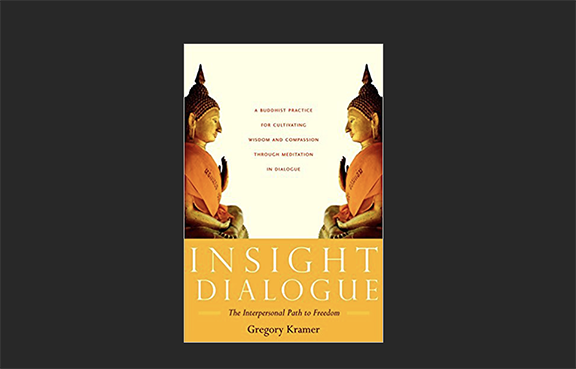 Gregory Kramer, Ph.D., offers participants in his Insight Dialogue workshops the opportunity to experience meditative awareness of what happens when we retreat into our habitually well-defended and lonely “constructed” selves. Through silent and guided meditation, and which takes place while communicating with others, participants get the chance to access an awareness that is not infiltrated with hunger and longing. Dr. Kramer describes how dwelling for even a moment in this unconstructed intimacy transforms our sense of the possible.
Gregory Kramer, Ph.D., offers participants in his Insight Dialogue workshops the opportunity to experience meditative awareness of what happens when we retreat into our habitually well-defended and lonely “constructed” selves. Through silent and guided meditation, and which takes place while communicating with others, participants get the chance to access an awareness that is not infiltrated with hunger and longing. Dr. Kramer describes how dwelling for even a moment in this unconstructed intimacy transforms our sense of the possible.
Integral Yoga Magazine: We tend to think of mindfulness meditation as a solitary practice.
Gregory Kramer: I think there are good reasons for this. Our contacts with others bring about such strong reactions. Just looking at someone, if you feel they may really see you, brings up wanting, shrinking. While meditating with others, we tend to be more aware of the judgments that come up: “What should I say to you? What will you think of me?” And we haven’t even gotten to talking to each other yet! [laughs] So, I think there is wisdom in being silent and finding mystical truth within.
IYM: Can relationship itself be an essential part of our spiritual practice?
GK: Over the last ten years, I’ve been exploring meditating with others. This began as an exploration of bringing consciousness to dialogue. But, what inspired me was the tremendous amount of suffering that comes up between people. So, in the meditation retreats I was doing, I saw that the same dynamics that unfold internally, are unfolding in the between of relational practice and that the suffering could be relieved.
IYM: Is relational practice part of your Buddhist tradition?
GK: Because my root tradition is Buddhism, I went to the earliest teachings, the Pali Sutras. The first noble truth is about suffering. The second noble truth concerns craving and this is what I was seeing as the origin of interpersonal suffering. Buddha talked about the three basic hungers: survival of self, the fears of self (nonbeing) and the urge for pleasure. My understanding of the interpersonal nature of these hungers is that the hunger for pleasure is also the fear of interpersonal pain—loneliness. A lot of relationships are based on the fear of loneliness. The hunger for being, is to be in the eyes of others: “Look at me, validate me, make me be.” That can become egoism and, in its extreme, narcissism. The hunger for nonbeing is the hunger to escape, to be invisible. It is the fear of intimacy or being discovered in our unworthiness, inadequacy. Ultimately, it is the basis of our addictions.
The third noble truth is that the cessation of suffering is brought about by the cessation of the hunger. You can think of this in terms of our interpersonal life: “When have I been with someone with no hunger to be pleasured by them, no fear of pain or no need to have them validate me?” What kind of freedom that is! If you think about it, aren’t the hungers what keep us from love and compassion? Because if I am hungry, you are food! In the absence of hunger, what arises naturally, without effort, is love and compassion. If I am not fixating on me, I can be present with you.
IYM: How do we achieve that?
GK: Well, the fourth truth is about the path, the way out of suffering. Now, if we construe the spiritual path as primarily an individual, solitary endeavor, then it follows that we construe relationship as outside the path. If we make the switch and say, “My whole life is my path,” that means my relationship with you and everyone is part of the path. Why would I leave out the deepest stillness, the mystical, the parts that reveal where I am fabricating delusions? Why would I leave that out of my spiritual path? Together, we fabricated a lot of delusion, so let’s get to work [laughs].
IYM: Okay! How?
GK: Three meditation instructions form the core of Insight Dialogue: Pause-Relax-Open, Trust Emergence, and Listen Deeply-Speak the Truth. The essence of this first instruction is to pause and step out of our identified moment and our delusion and step into mindfulness. We also want to open to mental tranquility and bodily calm by relaxing and accepting what is. Then, we want to extend and expand that awareness into our relationships.
The second instruction is to trust emergence, to release into the flow of experience. Now that I have opened and you are in my field of my awareness, thoughts arise, emotions arise, we are in relationship—we are not frozen staring at each other. We are moving with the impermanence, surrendering to the moment. We learn to dive into the changing moment with no agenda, with an unknowing mind and surrendering heart.
The last instruction has to do with listening and speaking. This is a place we get hooked and thus it needs attention. We want to cultivate listening deeply and speaking the truth. At a deeper level, that listening is the completely receptive heart. It’s an energetic presence, a receptive presence. To speak the truth is not just not telling lies but it is profound mindfulness that knows what the truth is in this moment—discernment and speaking the voice of the divine.
IYM: How does this work during a meditation session?
GK: In retreat, I offer those three meditation instructions and then support their development. Students start speaking and I may interrupt with a bell to help re-establish mindfulness and tranquility. We are not just chatting. I utilize contemplation themes drawn from all the deep world traditions—death, aging, disease, birth, impermanence, gratitude, judgment, self-concept.
If you are telling me a story and someone rings a bell and here you are in the midst of a sentence, you realize you were constructing the story in order for me to see you, to validate you. In retreat, that bell is like getting a mirror of our relational fabrications, our socially constructed self. I am trying to put together an image for your consumption and hopefully you are buying it. Our images are dancing with each other and that is usually the best we can do.
IYM: Would you give an example of some contemplation themes?
GK: One of the contemplations I give is, “What is the nature of the spiritual path and what is our capacity to awaken?” We address doubts, limiting beliefs. Even people who have been on the path for a long time have said, “I came to see I had quietly given up and felt, without even realizing it, I can’t be enlightened or awakened.” So, we look at those issues. Imagine as I am talking to you about doubt, that I am pausing and watching the well from which these words are coming up from—I see I am only speaking from habit-mind. I then might realize it is not truth; this is old karma speaking. It’s a sense of not just the potential for awakening but the truth of that awakened within me right now.
Themes can come from anywhere. [Picks up booklet by Swami Satchidananda, Heaven on Earth and reads a quote] “I have a commitment to make this a heaven.” So, I could give participants this topic: “Where are we making our heaven and where are we making our hell?” Or, here is another quote: “Be aware of any backbiting or animosity…” and so my question to the group might be: “Where am I living with hatred and how free can I be of hatred? I invite them to look at “judging mind” and we do it in a context of “pause, relax, and open,” which enables us so we step beyond our normal way of considering these topics. I may have lived with hatred in the past; now, I see hatred hurts me, and maybe I glimpse a letting go of that and of joy in that moment of letting go.
IYM: How do we expand those moments of joy, especially outside of the retreat or workshop context, and in the midst of our daily lives and relationships?
GK: The question is: “Can we meet outside of the norms of reaction, social habits, and the persona we’ve constructed?” Can we do that together and reveal to each other this truth that is not that fabrication. When I am meditating in the retreat environment, I have a strong, profound experience. I have been interacting with other people and the energy of awakening has been very strong. But how do I take that home? I find that as we do our spiritual practice, the energy of awakening becomes more and more visible and palpable and present; it’s not as easily disrupted by my relational habits because I have been developing new ways and habits.
I’ve witnessed in these retreats, how hearts are deeply touched and this bring moments of meditative intimacy, unconstructed intimacy; of being. These experiences help people get a taste of freedom from the hungers; they experience the freedom and compassion that is naturally within. I continue to be inspired by people who experience shifts in their being—often it’s like removing prison walls. The experience of fully present relationship is so powerful because beauty, generosity and even wisdom can be found inherent in human contact.
 Gregory Kramer, Ph.D. has taught Vipassana and Metta practice since 1980, and has studied with many Asian teachers. The author of Seeding the Heart: Practicing Lovingkindness with Children and Meditating Together, Speaking from Silence, Gregory is the founder/director of the non-profit Metta Foundation which is dedicated to offering teachings that enhance clarity, lovingkindness and mutuality. He co-created and for many years has extensively developed Insight Dialogue. For more information on his work, please visit: www.metta.org
Gregory Kramer, Ph.D. has taught Vipassana and Metta practice since 1980, and has studied with many Asian teachers. The author of Seeding the Heart: Practicing Lovingkindness with Children and Meditating Together, Speaking from Silence, Gregory is the founder/director of the non-profit Metta Foundation which is dedicated to offering teachings that enhance clarity, lovingkindness and mutuality. He co-created and for many years has extensively developed Insight Dialogue. For more information on his work, please visit: www.metta.org

